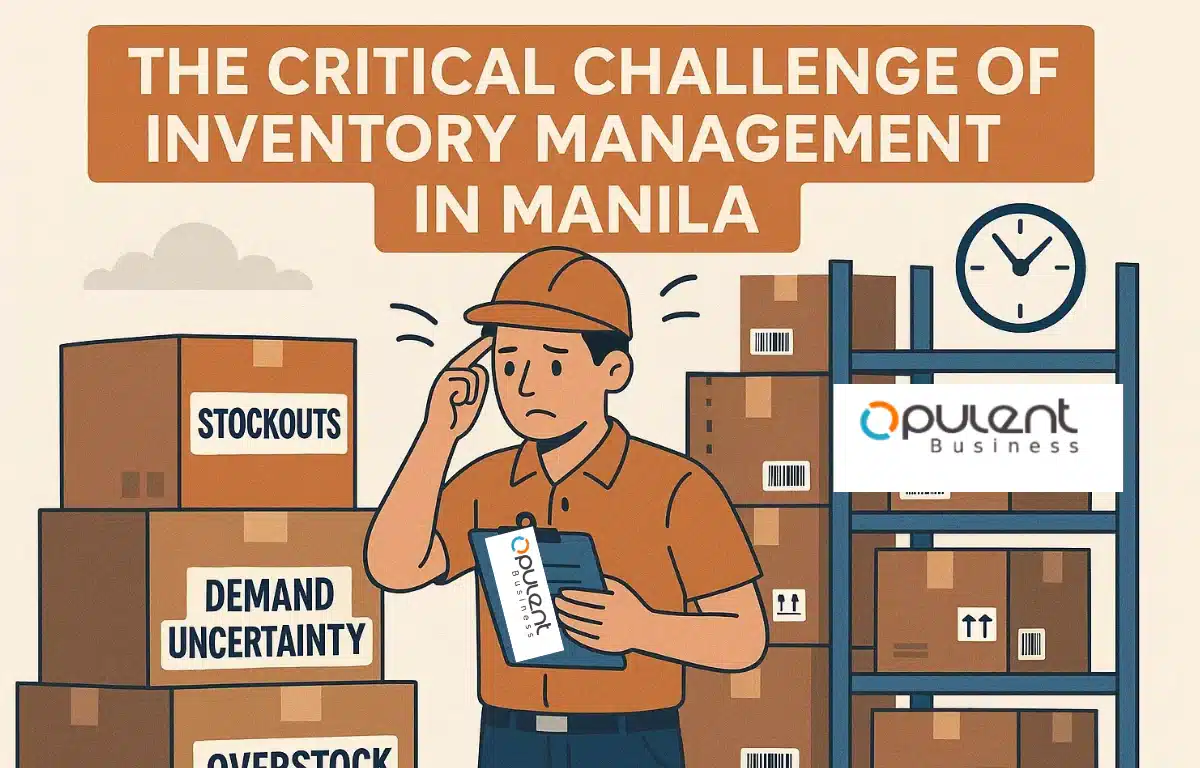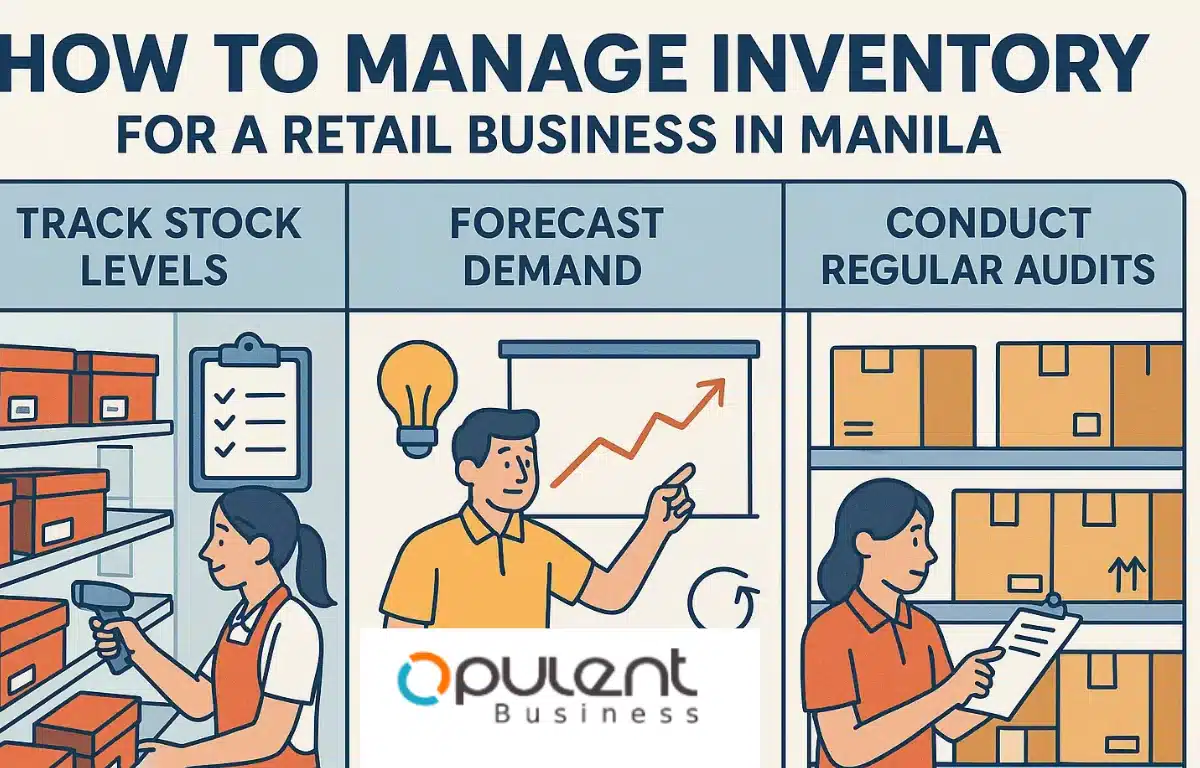Effective inventory management in Manila for retail businesses requires real-time tracking systems, strategic demand forecasting, and BIR-compliant software to navigate traffic delays, space constraints, and volatile demand patterns while maintaining optimal stock levels.
Are you losing money because your Manila retail store runs out of popular items just when customers need them most? You’re not alone. According to the Philippine Retailers Association’s Q4 2024 report, retailers who adopted real-time inventory systems experienced 35% faster stock turnover and 20% lower holding costs, saving millions of pesos from lost sales and overstock.
What You’ll Learn:
- 7 essential inventory tracking methods that work in Manila’s unique conditions
- Cost-saving formulas (ROI, EOQ) with real Filipino business examples
- BIR-compliant software solutions specifically designed for Philippine retailers
- Expert strategies to handle seasonal demand spikes and supply chain disruptions
Ready to transform your inventory chaos into competitive advantage? Let’s dive in.
The Critical Challenge of Inventory Management in Manila

Let us understand the Inventory management in Manila by an A 10-Step Guide to Inventory Accounting and Control with ERPexample. Managing inventory in Metro Manila presents unique obstacles that retailers worldwide don’t face. Traffic congestion across EDSA and Quezon Avenue regularly delays supplier deliveries, while premium real estate costs in areas like Makati and Bonifacio Global City force businesses into cramped spaces where every square meter counts.
Consider this reality: A convenience store in Quezon City reported 20% higher snack sales during barangay election week, while a Greenbelt boutique saw luxury item demand fluctuate by 40% during monsoon season. These dramatic shifts, combined with unpredictable logistics, make traditional inventory approaches inadequate.
Why Traditional Inventory Methods Fail in Manila
Space Limitations: Storefronts in Divisoria or Binondo often operate with minimal backroom storage, requiring precise stock level calculations.
Traffic-Induced Delays: Lead times from suppliers in Cavite can vary from 2-8 hours depending on traffic conditions, making standard reorder points unreliable.
Volatile Demand Patterns: Manila’s consumer behavior shifts rapidly based on weather, holidays, school schedules, and local events that traditional forecasting models can’t predict.
The solution lies in adopting inventory management systems specifically designed for Philippine retail conditions—systems that account for local logistics challenges while ensuring compliance with DTI and BIR requirements.
Essential Inventory Management Strategies for Manila Retailers
Understanding Your Inventory Types
Successful Manila retailers categorize their stock into three critical types:
Raw Materials: Components for in-house customization or assembly (particularly relevant for electronics stores in Greenhills or furniture shops in Marikina)
Finished Goods: Ready-to-sell items that directly generate revenue
MRO Supplies: Maintenance, repair, and operations materials including packaging, cleaning supplies, and point-of-sale materials
Each category requires different management approaches. A sari-sari store in Tondo focuses primarily on finished goods with minimal MRO supplies, while a custom t-shirt shop in Malate balances raw materials with finished inventory based on order patterns.
Key Performance Metrics That Drive Profitability
Monitor these critical inventory metrics to maintain competitive advantage:
Stock Turnover Rate: Measures how frequently you sell and replace inventory. Manila retailers typically achieve 8-12 turns annually, with convenience stores reaching 15+ turns in high-traffic locations.
Holding Costs: Include rent (averaging ₱1,200-₱3,500 per square meter monthly in prime Manila locations), insurance, spoilage, and opportunity costs of tied-up capital.
Lead Time Variability: Track not just average delivery times, but their consistency. Suppliers from Laguna might average 3 days but range from 1-7 days depending on conditions.
Advanced Inventory Tracking Methods
A. Digital Systems vs. Manual Methods
While small sari-sari stores might function with handwritten logs, businesses handling 50+ SKUs need digital solutions. Modern POS-integrated systems automatically adjust inventory as sales occur, providing real-time visibility crucial for high-volume Manila locations.
Real-World Example: A drugstore chain in Makati reduced stockouts by 60% after implementing POS-integrated inventory tracking, allowing them to identify fast-moving items and adjust reorder points based on actual sales velocity rather than estimates.
B. Demand Forecasting Techniques for Manila Markets
Seasonal Demand Patterns
Manila retailers must prepare for predictable seasonal shifts:
Rainy Season (June-October):
- 40% drop in outdoor recreation items
- 200% increase in umbrella and rainwear sales
- Higher demand for indoor entertainment products
School Opening Periods (June & August):
- 300% spike in school supplies and uniforms
- Increased lunchware and snack demand near schools
- Transportation-related items see higher sales
Holiday Season (October-December):
- Gift items experience 150-400% demand increases
- Decorative products peak between November 15-December 20
- Food products for parties and gatherings surge
Event-Driven Demand Spikes
Smart Manila retailers track local events that impact sales:
- Barangay festivals: 25-60% increase in party supplies and food items
- Payday periods: Consistent 30% sales boost during 15th and 30th weekends
- Mall-wide sales events: Can drive foot traffic up 200% but may require temporary staff increases
Calculating Optimal Reorder Points and Order Quantities
Reorder Point Formula Adapted for Manila Conditions
Standard Formula: ROP = (Average Daily Usage × Lead Time) + Safety Stock
Manila-Adapted Formula: ROP = (Average Daily Usage × Maximum Lead Time) + (Safety Stock × Traffic Delay Factor)
Practical Example: A electronics store in SM North EDSA sells 15 phone cases daily, with suppliers typically delivering in 3 days but sometimes taking 7 days due to traffic. They maintain 30 units as safety stock:
ROP = (15 × 7) + (30 × 1.2) = 105 + 36 = 141 units
This accounts for both extended delivery times and Manila-specific uncertainty factors.
Economic Order Quantity (EOQ) for Filipino Businesses
Formula: EOQ = √((2 × Annual Demand × Ordering Cost) / Annual Holding Cost per Unit)
Case Study: A beauty supply store in Greenhills:
- Annual demand: 3,600 lipsticks
- Ordering cost: ₱500 per order (including delivery fees)
- Holding cost: ₱12 per lipstick per year
EOQ = √((2 × 3,600 × 500) / 12) = √(300,000) ≈ 548 lipsticks
Instead of monthly orders of 300 units, they should order 548 units every 1.8 months, reducing total ordering and holding costs.
Technology Solutions for Philippine Retailers
BIR-Compliant Inventory Management Software
Philippine retailers must ensure their inventory systems generate BIR-acceptable records. Key requirements include:
Automated Documentation: Systems must create official receipts and sales invoices that link directly to inventory adjustments.
Audit Trail Maintenance: Every inventory change requires user identification, timestamps, and reason codes.
Tax Compliance Integration: Inventory valuations must align with BIR-acceptable accounting methods (FIFO, weighted average, or specific identification).
Recommended Solutions for Manila Businesses
StoreHub: Offers GCash integration and multi-location tracking, ideal for chains with 2-10 outlets across Metro Manila.
QNE Software: Provides robust desktop and cloud options with comprehensive BIR compliance features.
OpulentBiz: Specifically designed for Philippine SMEs, combining inventory management with BIR-compliant accounting and automated e-invoicing.
Overcoming Manila-Specific Inventory Challenges
Challenge 1: Supply Chain Disruptions
Problem: Traffic congestion and weather delays create unpredictable supplier performance.
Solution Strategy:
- Partner with 3-5 suppliers per critical item category
- Stagger delivery schedules to avoid peak traffic hours (10 AM-12 PM, 7 PM-9 PM)
- Maintain 15-25% higher safety stock for weather-sensitive periods
Real Implementation: A grocery chain in Quezon City reduced stockouts by 45% by scheduling deliveries between 5-7 AM and maintaining backup suppliers in Marikina for emergency replenishment.
Challenge 2: Counterfeit Product Infiltration
Problem: Unverified suppliers, particularly in wholesale districts like Divisoria, may introduce counterfeit goods.
Solution Framework:
- Implement barcode verification systems for all incoming inventory
- Train staff to identify authentic product characteristics
- Maintain supplier verification checklists and quality audits
- Use blockchain-enabled supply chain tracking where available
Challenge 3: Limited Storage Space Optimization
Problem: High real estate costs force retailers into compact spaces requiring maximum efficiency.
Space Optimization Strategies:
- Implement vertical storage solutions with clear labeling systems
- Use ABC analysis to place high-turnover items in easily accessible locations
- Consider 3PL partnerships for slow-moving inventory storage
- Adopt just-in-time ordering for predictable, high-value items
Integration with Sales and Customer Management
Modern Manila retailers must synchronize inventory across multiple channels:
Physical Store Integration: Real-time POS updates prevent overselling and provide accurate stock information to customers.
E-commerce Platform Sync: Automatic inventory updates across Shopee, Lazada, and TikTok Shop prevent overselling and maintain consistent availability information.
Customer Relationship Benefits:
- Personalized product recommendations based on purchase history and current stock levels
- Proactive notification of restocked items customers previously sought
- Bundling opportunities based on complementary product availability
Compliance and Record Keeping Requirements
DTI and BIR Documentation Standards
Philippine retailers must maintain comprehensive inventory records that satisfy government audit requirements:
Required Documentation:
- Daily inventory movement logs with transaction references
- Monthly physical count reconciliations
- Supplier delivery receipts with proper tax identification
- Customer sales documentation linking to inventory adjustments
Best Practices for Compliance:
- Conduct weekly spot checks on high-value items
- Maintain digital backups with 3-year retention policies
- Train staff on proper documentation procedures
- Schedule quarterly internal audits to identify compliance gaps
How Opulent Business Optimizes Manila Retail Inventory
Opulent Business addresses the specific challenges Manila retailers face through localized features:
BIR-Compliant Automation:
- Automatic generation of official receipts linked to inventory adjustments
- Built-in tax calculation aligned with current Philippine regulations
- Audit-ready reports formatted for BIR requirements
Manila-Specific Features:
- Traffic delay factors in reorder point calculations
- Integration with local payment systems (GCash, PayMaya, bank transfers)
- Multi-location tracking for retailers with branches across Metro Manila
- Supplier performance tracking with Manila logistics considerations
Implementation Support:
- On-site training sessions conducted in Filipino and English
- 24/7 technical support understanding Philippine business hours
- Integration assistance with existing accounting and POS systems
Ready to transform your inventory management from a daily struggle into a competitive advantage? Schedule your free Opulent Business consultation today and discover how our Manila-optimized inventory system can reduce your costs, eliminate stockouts, and ensure full BIR compliance.
Frequently Asked Questions
What is the best inventory management method for small Manila retailers?
For small Manila retailers (under 100 SKUs), a cloud-based POS-integrated system like StoreHub or OpulentBiz provides the optimal balance of functionality and affordability. These systems offer real-time tracking, BIR compliance, and can handle Manila’s unpredictable supply chain conditions without requiring extensive technical expertise.
How often should I conduct physical inventory counts in my Manila store?
Manila retailers should perform full physical counts monthly for high-value items and quarterly for complete inventory. Additionally, implement weekly cycle counting for your top 20% of products (ABC analysis A-items) to maintain accuracy despite the rapid turnover common in Manila’s retail environment.
What safety stock levels work best for Manila’s unpredictable delivery schedules?
Due to Manila’s traffic and weather-related delivery delays, maintain safety stock equal to 20-30% of your average monthly sales for critical items, compared to the global standard of 10-15%. For seasonal items during rainy season or holidays, increase safety stock to 40-50% to handle both demand spikes and potential supply disruptions.
How can I ensure my inventory system complies with BIR requirements?
Choose inventory management software specifically designed for Philippine businesses, such as OpulentBiz or QNE Software. These platforms automatically generate BIR-compliant documentation, maintain proper audit trails, and integrate with Philippine tax reporting requirements. Ensure your system can produce detailed inventory movement reports and maintains transaction-level documentation for at least 3 years.
What’s the most cost-effective way to handle inventory for multiple Manila store locations?
Implement a centralized inventory management system that provides real-time visibility across all locations while allowing individual store-level control. Consider using a hub-and-spoke distribution model with a central warehouse in accessible areas like Pasig or Marikina, combined with inter-store transfer capabilities to balance inventory based on location-specific demand patterns.


